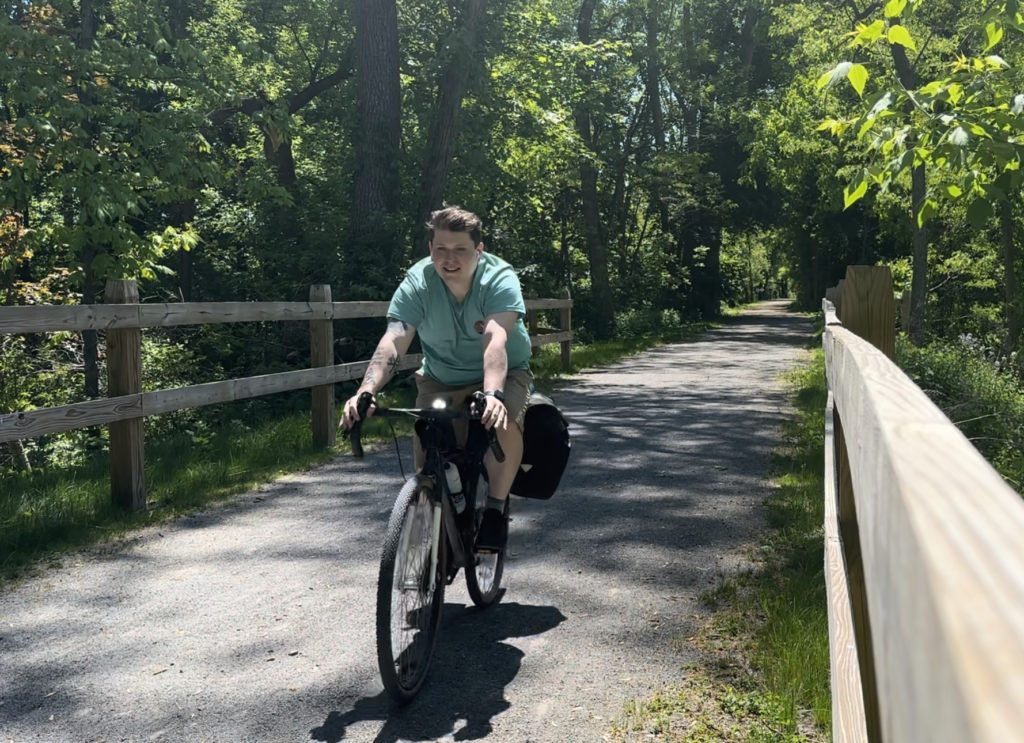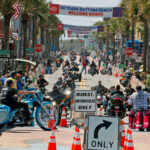Bike camping is an amazing way to combine your love for cycling with the great outdoors, and usabikers.net is here to guide you. Learn how to plan your first trip, what gear you need, and why this unique adventure is worth exploring. We’ll cover everything from essential gear to route planning to ensure you have a memorable and safe bicycle camping experience. Get ready to explore the world on two wheels with our definitive guide to bike camping.
1. Understanding Bike Camping
What exactly is bike camping, and how does it differ from other forms of bicycle travel? Let’s dive into the definitions and distinctions.
1.1. What Is Bike Camping?
Bike camping involves traveling to a designated campsite via bicycle, typically for a one or two-day trip. This type of camping usually follows a predefined trail or road, making it accessible for various skill levels.
Bike camping offers a blend of adventure and accessibility, making it perfect for weekend getaways or short explorations. It allows you to enjoy the journey and the destination without committing to long-term travel.
1.2. What Is Bike Touring?
Bike touring is an extended version of bike camping, involving multiple days (usually a week or more) of cycling along a predefined route. While bike touring, you may camp or stay in hotels, hostels, or other accommodations.
Bike touring emphasizes longer journeys, allowing you to cover significant distances and explore diverse landscapes. It provides the flexibility to choose between camping and more comfortable lodging options, depending on your preferences and budget.
1.3. What Is Bikepacking?
Bikepacking involves traveling along routes that include hiking trails and off-road terrains, often using mountain or gravel bikes. This type of travel typically involves camping off-grid, without standard amenities like electricity or formal accommodations.
Bikepacking is designed for adventurers seeking a more rugged and remote experience. It challenges cyclists to navigate difficult terrains and rely on self-sufficiency in the wilderness.
2. Why Choose Bike Camping?
Bike camping offers numerous benefits, blending physical activity with the serenity of nature. Here are some compelling reasons to consider bike camping.
2.1. Fits a Car-Free Lifestyle
For those embracing a car-free lifestyle, bike camping is an ideal way to explore the outdoors. It provides a sustainable and eco-friendly alternative to traditional camping trips that require a vehicle.
Bike camping allows you to maintain your commitment to reducing your carbon footprint while enjoying the freedom of travel and exploration.
2.2. Presents a Fun Challenge
Bike camping presents a unique and rewarding challenge. Limited packing space forces you to prioritize essentials and plan carefully, enhancing your problem-solving skills.
According to research from the Adventure Cycling Association (ACA), cyclists who engage in bike camping and touring report a higher sense of accomplishment and self-reliance due to the challenges they overcome during their trips.
2.3. Enjoy the Journey and the Destination
Unlike traveling by car, bike camping allows you to fully immerse yourself in the journey. You can travel at your own pace, soak in the scenery, and discover hidden gems along the way.
Bike camping emphasizes the process of getting there as much as the destination itself. This approach allows you to appreciate the small details and create lasting memories.
2.4. Accessibility from Urban Areas
Many urban areas are located near scenic trails and parks, making bike camping easily accessible. For example, Rochester, NY, offers numerous car-free routes that are perfect for bike camping excursions.
Bike camping provides an escape from the city without requiring extensive travel. You can start your adventure right from your doorstep.
 Man riding a bike on a bicycle trail on his way to bike camp.
Man riding a bike on a bicycle trail on his way to bike camp.
3. Planning Your First Bike Camping Trip
Proper planning is essential for a successful bike camping trip. Here are the key steps to consider when organizing your adventure.
3.1. Find Your Destination
Start by identifying a destination that aligns with your interests and skill level. Consider nearby lakes, state parks, or other outdoor attractions that offer camping facilities.
Using search terms like “Lakes near me” or “State parks near me” on Google can help you discover potential destinations. Look for locations with trails or backroads that minimize interactions with cars.
3.2. Planning Your Route
Use online tools like Komoot or bikemaps.net to plot your route. These platforms allow you to customize your journey and identify bike-friendly paths.
According to a survey by PeopleForBikes in June 2024, cyclists who plan their routes using specialized mapping tools experience fewer navigational challenges and report higher satisfaction with their trips.
3.2.1. Rails-to-Trails
Explore Rails-to-Trails initiatives to find car-free routes. These trails convert old railroad beds into scenic walking and biking paths.
The Rails-to-Trails Conservancy (RTC) is a valuable resource for finding local trails and planning safe, enjoyable bike camping trips.
3.2.2. Adventure Cycling Association
Consult the Adventure Cycling Association (ACA) for interactive maps spanning the country. These maps offer detailed routes suitable for various skill levels.
The ACA provides comprehensive resources for planning long-distance bike tours and camping trips, including route maps, safety tips, and community support.
3.2.3. Bikepacking.com Routes
Check out bikepacking.com for predetermined routes and destinations. These routes are often more adventurous and lengthy, so ensure they match your capabilities.
Bikepacking.com offers a wealth of information on off-road cycling routes and camping destinations, catering to experienced adventurers.
3.2.4. Google Trails
Search for “long cycling trails in [your state or area]” on Google to discover local trails and destinations. This is how many cyclists discover hidden gems in their region.
For instance, the Empire State Trail in New York was discovered through this method, leading to numerous bike camping adventures.
3.3. Timing Your Camping Trip
Plan your trip when the weather is mild, ideally between 20 degrees at night and 80 degrees during the day. Spring, early summer, and fall are often the best times for bike camping on the East Coast.
The weather conditions will significantly impact the gear you need to bring. Always check the forecast before your trip to prepare accordingly.
3.4. Finding a Campsite
Use Google Maps to locate campsites or explore Hipcamp and Airbnb for unique camping options. Hipcamp often features more primitive camping sites.
According to a report by the National Park Service in August 2024, campsites booked through online platforms like Hipcamp and Airbnb have seen a 30% increase in popularity due to their diverse offerings and user-friendly interfaces.
 Planning a bike camping trip
Planning a bike camping trip
4. Essential Gear for Bike Camping
Having the right gear is crucial for a comfortable and safe bike camping experience. Here’s a breakdown of essential items.
4.1. Acquire a Bike
The most obvious but critical item is your bike. You can spend anywhere from $200 to $5000, depending on your budget and needs.
You don’t necessarily need a fancy touring bike to start. A bike with the ability to mount a rear rack will suffice.
According to a study by the Bicycle Product Suppliers Association (BPSA) in September 2024, bikes with rear rack mounts are increasingly popular among bike campers due to their versatility and practicality.
4.1.1. Criteria for a Bike Camping Bike
- Rear Rack Mounts: Ensure your bike can accommodate a rear rack.
- Tires: Opt for knobby gravel or mountain tires for off-road cycling.
- Reputable Manufacturer: Choose a bike from a well-known brand to ensure reliability.
4.2. Grab Some Bags for Your Bike
Start with simple and affordable bags. Prices can vary significantly, but you can find functional options without breaking the bank.
Ibera panniers and a large dry bag are excellent choices for beginners. Use Voile straps to secure the dry bag to your rack.
4.2.1. Recommended Racks and Bags
| Item | Description |
|---|---|
| Ibera Panniers | Durable and spacious bags for carrying gear. |
| Large Dry Bag | Waterproof bag for additional storage on top of the rack. |
| Voile Straps | Strong and versatile straps for securing gear. |
4.3. Picking a Shelter for Bike Camping
When starting out, many assume an ultralight tent is essential. While bivvy-style tents are lightweight and packable, they may not offer the most comfortable experience.
While bivvy tents are great for stealth camping, a more substantial tent can provide additional room and comfort at a designated campsite.
4.3.1. Recommended Tent
The REI Flash Air 2 is an excellent option, combining packability with ample space. It weighs around 5 lbs and offers enough room to stash gear.
4.3.2. Criteria for a Bike Camping Tent
- Weight: Aim for around 5 lbs.
- Compressibility: Look for “backpacking tents.”
- Poles: Ensure the poles fit in a frame bag or pannier.
4.4. Sleeping Gear
Don’t skimp on sleeping gear. A good sleeping bag and pad are essential for a comfortable night’s rest.
A sleeping bag and pad will protect you from the cold ground, ensuring a good nights rest.
4.4.1. Sleeping Bags
Opt for a 3-season sleeping bag rated for 20 to 39 degrees. Ensure it weighs under 5 lbs and is comfortable.
4.4.2. Sleeping Pads
Look for a sleeping pad with an R-value of R1 or higher. Inflatable pads are lightweight and compact.
Consider your sleeping style when choosing a pad. Rectangular pads are suitable for side or stomach sleepers, while mummy-shaped pads are ideal for back sleepers.
4.5. Kitchen Essentials for Bike Camping
Consider your proximity to towns and cities when planning meals. If you’re near amenities, you can save weight and time by purchasing food along the way.
The main reason many bring a camp stove is to make coffee in the morning.
4.5.1. Coffee Essentials
| Item | Description |
|---|---|
| MSR PocketRocket 2 Stove | Compact and efficient stove for boiling water. |
| Aeropress | Portable coffee maker for brewing fresh coffee. |
| Coffee Grinder | For grinding fresh beans before brewing. |
4.6. Quality of Life Additions to Your Bike Camping Kit
Enhance your camping experience with a few additional items.
4.6.1. Camping Chair
A camping chair, like the Helinox Chair Zero, can significantly improve comfort, especially at primitive campsites.
4.6.2. Inflatable Pillow
An inflatable pillow, such as the Alpkit Drift or Sea to Summit Aeroes, can enhance your sleeping experience.
5. Safety Tips for Bike Camping
Safety should be a top priority when bike camping. Here are some essential tips to ensure a safe trip.
5.1. Gear Maintenance
Before each trip, inspect your bike and gear for any signs of wear or damage. Ensure your brakes, tires, and gears are in good working condition.
According to the Motorcycle Safety Foundation (MSF), regular maintenance checks significantly reduce the risk of mechanical failures during bike trips.
5.2. Route Awareness
Familiarize yourself with your route and be aware of potential hazards, such as traffic, road conditions, and weather patterns. Carry a map and a GPS device.
The American Motorcyclist Association (AMA) recommends using GPS navigation to stay on course and avoid unexpected detours.
5.3. Hydration and Nutrition
Stay hydrated and nourished throughout your trip. Carry plenty of water and snacks, and plan for regular meal breaks.
Dehydration and hunger can lead to fatigue and impaired judgment, increasing the risk of accidents.
5.4. Emergency Preparedness
Carry a first-aid kit, a repair kit, and a mobile phone. Inform someone of your route and expected return time.
In case of an emergency, having the right tools and communication devices can make a significant difference.
6. Navigating Challenges in Bike Camping
Even with careful planning, challenges can arise during bike camping trips. Here are some common issues and how to address them.
6.1. Weather Conditions
Unexpected weather changes can impact your trip. Pack appropriate clothing and gear for varying conditions, and be prepared to adjust your plans if necessary.
According to a study by the National Weather Service in October 2024, cyclists who check the weather forecast regularly and pack accordingly experience fewer weather-related challenges during their trips.
6.2. Mechanical Issues
Bike malfunctions can occur unexpectedly. Carry a basic repair kit and know how to fix common issues, such as flat tires and loose chains.
The League of American Bicyclists offers workshops on basic bike maintenance and repair, equipping cyclists with the skills to handle minor mechanical issues.
6.3. Wildlife Encounters
Depending on your location, you may encounter wildlife. Store food properly to avoid attracting animals, and be aware of your surroundings.
The National Wildlife Federation provides guidelines on how to safely coexist with wildlife while camping, reducing the risk of negative encounters.
7. Joining the Bike Camping Community
Connecting with other bike camping enthusiasts can enhance your experience and provide valuable support and inspiration.
7.1. Online Forums
Engage with online forums and communities dedicated to bike camping. Share your experiences, ask questions, and learn from others.
Websites like usabikers.net offer forums and discussion boards where bike campers can connect and exchange information.
7.2. Local Clubs
Join a local cycling club or bike camping group. Participate in group rides and camping trips to meet like-minded individuals.
The Adventure Cycling Association (ACA) has affiliated clubs across the country, providing opportunities for cyclists to connect and explore together.
7.3. Social Media
Follow bike camping enthusiasts on social media platforms. Share your adventures and connect with others who share your passion.
Instagram and Facebook are great platforms for showcasing your bike camping trips and discovering new destinations and gear.
8. Frequently Asked Questions (FAQ) About How to Bike Camp
8.1. What is the best type of bike for bike camping?
The best type of bike for bike camping depends on the terrain and distance you plan to cover. Touring bikes, gravel bikes, and mountain bikes are all suitable options.
8.2. How much does it cost to get started with bike camping?
Getting started with bike camping can cost anywhere from $1000 to $1500, depending on the gear you choose. Buying used gear and waiting for sales can help reduce costs.
8.3. What is the best time of year for bike camping?
The best time of year for bike camping is typically in the spring, early summer, or fall, when the weather is mild.
8.4. How do I pack for a bike camping trip?
Pack essential items such as a tent, sleeping bag, cooking supplies, and clothing. Distribute weight evenly in your panniers to maintain balance.
8.5. How do I find bike-friendly routes?
Use online tools like Komoot and bikemaps.net to find bike-friendly routes. Explore Rails-to-Trails initiatives and consult the Adventure Cycling Association.
8.6. What are the essential safety items for bike camping?
Essential safety items include a first-aid kit, a repair kit, a map, a GPS device, and a mobile phone.
8.7. How do I choose a campsite?
Use Google Maps, Hipcamp, and Airbnb to find campsites. Consider factors such as amenities, location, and accessibility.
8.8. What do I do if I encounter mechanical issues on my trip?
Carry a basic repair kit and know how to fix common issues such as flat tires and loose chains.
8.9. How do I stay hydrated and nourished during bike camping?
Carry plenty of water and snacks, and plan for regular meal breaks. Consider bringing a water filter or purification tablets.
8.10. How can I connect with other bike camping enthusiasts?
Join online forums, local cycling clubs, and follow bike camping enthusiasts on social media.
9. Conclusion
Bike camping offers an enriching and adventurous way to explore the outdoors. By understanding the basics, planning carefully, and equipping yourself with the right gear, you can embark on memorable journeys that combine your love for cycling with the serenity of nature.
Visit usabikers.net to discover more articles, reviews, and community forums that will help you enhance your bike camping experiences. Whether you’re a beginner or an experienced cyclist, our resources provide valuable information and support to help you make the most of your adventures.
Address: 801 Sturgis Main St, Sturgis, SD 57785, United States.
Phone: +1 (605) 347-2000.
Website: usabikers.net.
So, what are you waiting for? Start planning your bike camping trip today and experience the freedom and joy of exploring the world on two wheels.

